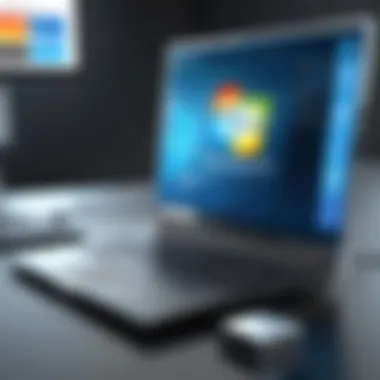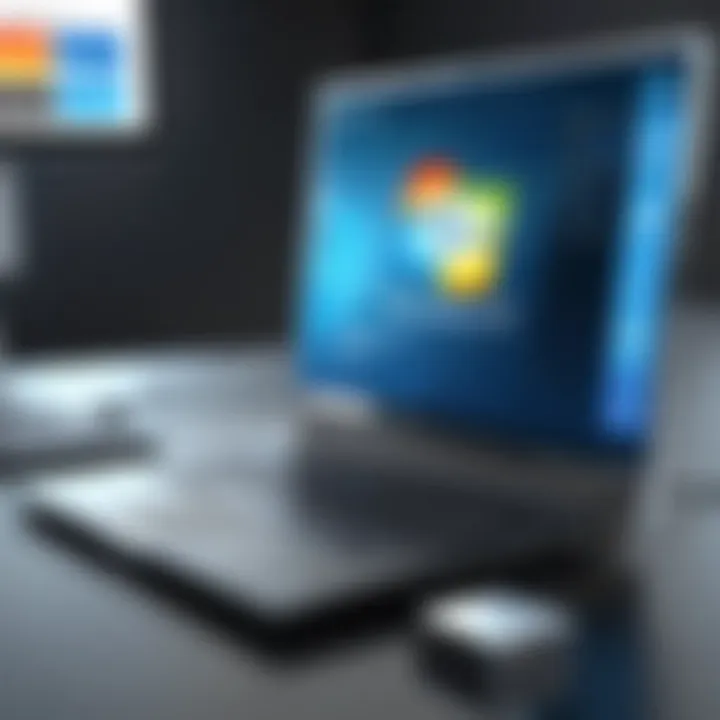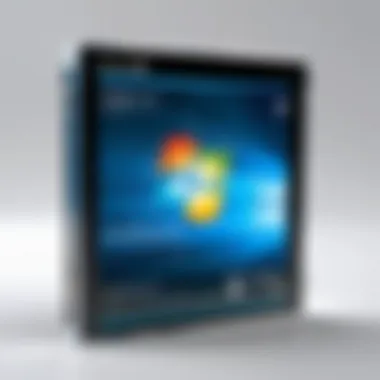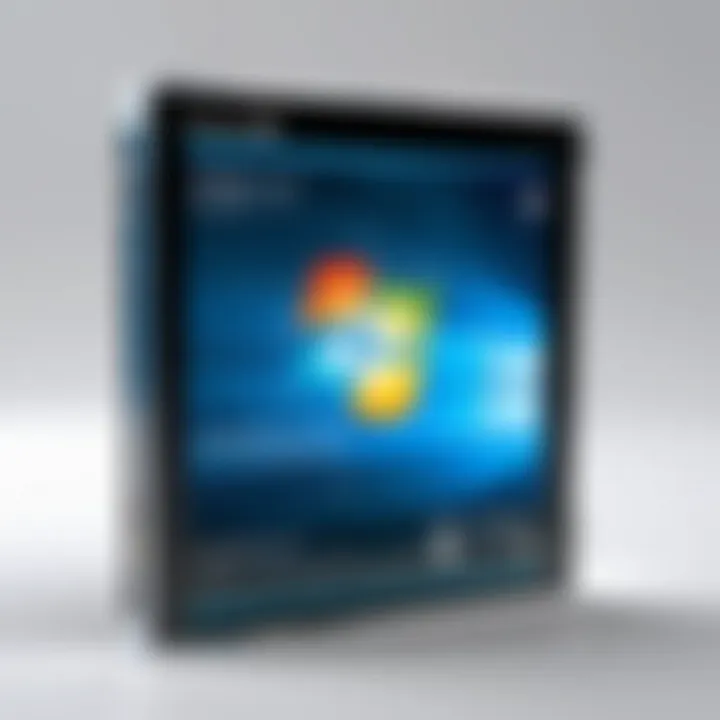Boot Windows 7 from USB Drive: IT Pro's Guide


Intro
Booting Windows 7 from a USB drive is a critical process for IT professionals. This capability is invaluable in various scenarios like installing the operating system on new hardware or performing system recovery. Understanding how to set this up correctly can greatly affect efficiency and effectiveness in IT operations. The use of USB drives also addresses some limitations of older installation methods, such as DVDs, which can be slower and less reliable.
In this guide, we discuss prerequisites, the step-by-step process for creating a bootable USB, and common troubleshooting techniques. We aim to equip technology enthusiasts and IT professionals with comprehensive knowledge about this process. By the end of this guide, readers will have the tools needed to manage Windows 7 installations seamlessly and smartly.
Features Overview
Key Specifications
- Compatibility: Windows 7 is compatible with a variety of USB drive sizes, but it is recommended to use at least an 8GB drive to ensure sufficient space for system files.
- File System Format: The USB drive should be formatted to NTFS or FAT32 prior to creating the bootable drive, as this affects the installation process and file accessibility.
- Booting Method: BIOS and UEFI are the two major firmware interfaces for booting; knowing which one your hardware utilizes is vital for a successful boot process.
Unique Selling Points
- Speed: USB installations are generally faster compared to traditional optical drives, saving time during setup.
- Portability: A USB drive can be easily transported and used in various systems without the need for physical media.
- Multi-Functionality: Once created, the USB drive can also serve as a recovery tool or for troubleshooting, making it more versatile than a DVD.
Performance Analysis
Benchmarking Results
Performance metrics indicate significant improvements when booting from USB compared to DVD. Benchmarks show that users can expect faster load times, especially when using newer USB 3.0 drives.
Real-world Scenarios
In real-world scenarios, the importance of USB booting is emphasized. For example, IT professionals frequently use bootable USB drives for troubleshooting corrupted systems or deploying new installations. This method is preferable in environments where time efficiency is critical.
"Creating a bootable USB with Windows 7 can streamline installation processes and enhances recovery capabilities."
In the subsequent sections, we will delve deeper into creating a bootable USB, necessary tools, and advanced troubleshooting techniques.
Understanding USB Booting
The concept of USB booting is crucial for IT professionals who manage systems and installations. As technology evolves, the methods of deploying operating systems have also progressed. USB booting serves as an efficient and versatile method for initiating installations of various operating systems, including Windows 7. In the realm of system administration, understanding the fundamentals of USB booting is not merely advantageous—it is essential.
USB drives have become the primary medium for installation due to their speed, portability, and ease of use. This has rendered outdated methods, like DVD or CD booting, less favorable. By mastering USB booting, IT professionals gain a strategic edge in terms of performance and flexibility. Additionally, USB booting accommodates diverse hardware configurations and is compatible with a broad range of systems.
The shift toward USB booting is not only about convenience. It also involves significant considerations in security and data management. In environments where multiple systems require installation or recovery, USB booting allows for a rapid response to operational needs. Understanding this process prepares IT practitioners for diverse challenges and ultimately increases their overall effectiveness.
Definition of USB Booting
USB booting refers to the process of starting a computer using a USB flash drive that contains the necessary files to load the operating system. This method involves setting the computer’s BIOS firmware to prioritize USB devices over the standard hard drive. Upon successful initiation, the computer loads the operating system files from the USB drive, allowing the user to install or run the system as if it were booting from a permanent installation medium.
One key aspect of USB booting is the need for a correctly configured and formatted USB drive. It must be made bootable, which typically requires specific tools or software that can transfer the operating system image onto the USB drive. This process is vital to ensure seamless system installation.
Importance in IT
In the IT sector, the ability to boot systems from USB drives has become indispensable. Several factors underscore its importance:
- Efficient Deployment: USB booting facilitates rapid deployment across multiple devices in a network, reducing downtime and increasing productivity.
- Versatility: USB drives can store various operating systems, making it easy to run different setups on different machines without hassle.
- Hardware Compatibility: The approach bypasses hardware limitations often associated with CD/DVD drives, which may not be present in slim laptops or ultra-portable systems.
- Repair and Recovery: For troubleshooting or recovery tasks, having a bootable USB drive simplifies processes that may otherwise require complex configurations.
"Understanding USB booting is a prerequisite for any IT professional wishing to streamline OS deployment and maintenance processes."
The implications of being proficient in USB booting extend beyond basic OS installations. Knowledge in this area opens doors to more advanced tasks, such as multi-boot management and recovery options, further enhancing an IT professional’s skill set. It positions them to handle various scenarios effectively, ensuring they meet operational demands with ease.
Prerequisites for Booting Windows from USB
Before diving into the process of booting Windows 7 from a USB drive, it is crucial to understand the prerequisites that lay the groundwork for a successful installation. Meeting these prerequisites not only streamlines the entire procedure but also minimizes potential pitfalls that can arise during installation. This section discusses the essential tools, software, and system requirements necessary to effectively boot Windows 7 from a USB drive.
Required Tools and Software
To initiate the booting process of Windows 7 via USB, several key tools and software are essential. These components facilitate the creation and management of the bootable USB drive. Below is a detailed list of these necessities:
- Windows 7 ISO File: The installation files are housed in an ISO file, which can be sourced from official Microsoft websites or reputable third-party vendors. This file is fundamental as it contains the Windows operating system needed for installation.
- Bootable USB Creation Software: Several tools facilitate the conversion of a standard USB drive into a bootable device. Notable examples include Rufus, UNetbootin, and Windows USB/DVD Download Tool. Each tool has unique features, but they all serve the same primary function: preparing the USB drive for booting.


Benefits of Using These Tools
- Efficiency: Using a dedicated tool saves considerable time and effort compared to manual methods.
- Reliability: These software options are designed to create bootable drives without common errors often encountered through manual setups, ensuring a smoother installation process.
- User-Friendly: Most of these tools have intuitive interfaces, making them accessible for users with varying technical expertise.
System Requirements
Before proceeding, it is also critical to verify if the target system meets the minimum requirements for Windows 7. Below are the key system specifications:
- Processor: 1 GHz or faster 32-bit (x86) or 64-bit (x64) processor. This is the basic requirement for any Windows OS.
- RAM: At least 1 GB for 32-bit or 2 GB for 64-bit systems. This will affect how well the operating system runs.
- Hard Disk Space: A minimum of 16 GB of available hard disk space is essential for a 32-bit installation and 20 GB for a 64-bit installation.
- Graphics Card: DirectX 9 graphics device with WDDM 1.0 or higher driver. This requirement ensures that visual elements are rendered correctly.
- Optical Drive or USB Port: A USB port is necessary since we are using a USB drive for the installation process.
Verifying these specifications ensures that the system can handle Windows 7 and prevents complications during installation, which can be frustrating for IT professionals and tech enthusiasts alike.
Ensure that both the tools and system requirements are aligned before you begin the booting process. This will save valuable time and ensure a smoother installation journey.
Creating a Bootable USB Drive
Creating a bootable USB drive is a crucial step in facilitating the installation of Windows 7. This process empowers IT professionals to quickly and efficiently set up operating systems across multiple machines. By utilizing USB drives, users can bypass the traditional DVD installation, which can be slower and less convenient. The reduction in installation time is a significant benefit when managing multiple systems in an organization or during troubleshooting scenarios.
Selecting the Right USB Drive
Choosing the correct USB drive is fundamental to achieving a successful installation. Not all USB drives are created equal. In general, it is recommended to use a USB drive with at least 8 GB of storage. This allows sufficient space for the Windows 7 installation files along with any necessary drivers or system updates. Furthermore, it is wise to select drives that have a good read/write speed. Faster drives can diminish the time needed for both the format process and file transfer. Using a reliable brand can significantly impact the success of the installation.
Formatting the USB Drive
Using FAT32 vs NTFS
When formatting a USB drive for Windows 7 installation, the file system choice can markedly influence the process. FAT32 is widely used due to its compatibility with most systems. It is essential for maintaining the ability to boot on both UEFI and BIOS systems. Nonetheless, FAT32 has a file size limitation of 4 GB, which could pose issues if the Windows installation file exceeds this limit. On the contrary, NTFS does not have this limitation. However, it is less universally compatible when it comes to older machines.
It is advisable to use FAT32 for broader compatibility, unless large file sizes necessitate the use of NTFS.
Steps for Formatting
The formatting process is straightforward. Here’s a brief overview:
- Insert the USB Drive into the computer.
- Open File Explorer and right-click on the USB drive.
- Select Format from the context menu.
- Choose the File System (FAT32 or NTFS).
- Check Quick Format for a faster process.
- Click Start to begin formatting.
This sequence of steps ensures that the USB drive is prepared properly for the installation files, allowing for an effective boot process once completed.
Transferring Windows Files
The final component of the bootable USB drive creation is transferring the Windows 7 installation files. This involves extracting the ISO file, which contains the installation data, onto the formatted USB drive. Using tools like Rufus can significantly simplify this process. These applications ensure correct file arrangement and boot sector configuration. Having an organized drive structure increases the likelihood of a successful boot from USB and smooth installation process.
BIOS Settings for Booting from USB
BIOS settings play a critical role in the process of booting Windows 7 from a USB drive. Understanding how to properly configure these settings can significantly impact the success of the installation. BIOS, or Basic Input/Output System, is firmware that initializes hardware during the booting process. It ensures that the system uses the right sequence to load the operating system. If the USB is not prioritized in these settings, the system may fail to boot from it, leading to installation delays or failures.
Accessing BIOS
Accessing BIOS is the first step in modifying settings for USB booting. The process varies among manufacturers but often requires pressing a specific key during the initial boot sequence. Keys like F2, Del, or Esc are commonly used.
- Turn on your computer.
- Immediately press the required key multiple times during startup.
- Once in the BIOS menu, navigate with the keyboard, as mouse functionality may be limited.
- Look for a section labeled 'Boot' or 'Boot Options'.
Each BIOS has a different layout and terminology, so spend time familiarizing yourself with its interface for efficient navigation.
Changing Boot Order
Changing the boot order is essential to ensure the USB drive is prioritized. The boot order dictates the sequence of devices checked for bootable software. Here’s how to change it:
- In the BIOS menu, locate the 'Boot Order' or 'Boot Priority'.
- Use the arrow keys to highlight the USB drive.
- Follow the on-screen instructions (often involves using keys like + or -) to move the USB drive to the top of the list.
- Save changes before exiting, which is usually done by pressing F10.
The correct boot order configuration guarantees that the system will attempt to boot from the USB before any other devices, such as the hard drive.
Secure Boot Considerations
Secure Boot is a feature designed to protect against unauthorized software. It can prevent the USB drive from being recognized during boot. To successfully boot Windows 7 from USB, consider the following:


- Disable Secure Boot: Access the BIOS menu, find the Secure Boot option, and set it to Disabled.
- Ensure Compatibility: Make sure the USB drive is set up with compatible settings, such as UEFI or Legacy Mode.
It's crucial to approach this with caution, as disabling Secure Boot can expose the system to risks if not followed by proper security practices. It’s recommended to revert this setting after installation to maintain system integrity.
"Configuring BIOS settings correctly is a fundamental aspect for ensuring a successful operating system installation."
By effectively understanding and managing the BIOS settings related to booting from USB, IT professionals can streamline the installation of Windows 7, avoiding common pitfalls that could otherwise hinder the process.
Booting the System
Booting the system is a foundational step in the installation of Windows 7 from a USB drive. The importance of this process cannot be overstated, as it sets the stage for the entire installation and configuration of the operating system. Correctly booting from the USB ensures that the system's hardware recognizes the bootable media and proceeds with the installation without interruptions. It is the culmination of the earlier stages like preparing the USB drive and adjusting BIOS settings.
A successful boot from the USB drive not only promotes efficiency but also minimizes potential downtime. Particularly for IT professionals, understanding the nuances of booting is essential. This phase is where many common issues can surface, making it imperative for professionals to be well-informed about the required steps and potential obstacles.
Starting the Installation Process
Once the system has booted from the USB drive, the installation process can begin. At this stage, users are greeted with the Windows 7 setup interface, signaling that the operating system is ready to be installed. The significance of this phase lies in its structure; it guides the user through configuring essential settings and selections that determine how the operating system will behave upon finalization.
Within this initial setup, key choices include language, time, and keyboard settings. Users should ensure the selections align with their locale and preferences. The interface is designed to be user-friendly, which helps in navigating through the installation steps smoothly. Furthermore, it is a chance to verify that the hardware is compatible with Windows 7, as any incompatible components can result in further complications down the line.
Navigating the Installation Interface
The installation interface is critical for guiding users through the setup process. IT professionals should be adept at maneuvering through this interface. It includes several prompts for installation types, such as upgrading an existing installation or performing a clean install.
The user must identify the correct installation type based on their needs. Moreover, the interface allows for partition selection for the operating system. It is advisable to understand how to partition drives effectively, as this affects performance and storage management.
Take note of the following options available during navigation:
- Upgrade: Keeps existing files and settings while installing Windows 7.
- Custom: Allows for a fresh installation but requires partition management.
Ensure all necessary backups are in place before commencing the installation, especially when choosing the custom installation route.
Post-Installation Considerations
After successfully booting Windows 7 from a USB drive and completing the installation process, two major areas come into focus: driver installation and system updates. Both elements are paramount in ensuring the newly installed operating system runs smoothly and efficiently. Addressing these areas is essential not only for optimal performance but also for maintaining system security and compatibility with hardware.
Driver Installation
The installation of drivers is a critical step post-Windows installation. Drivers are essential software that enable the operating system to communicate effectively with hardware components, such as graphics cards, sound cards, and network adapters. Without the correct drivers, you may experience poor performance, hardware malfunction, or even the inability to use certain features of the device.
To install drivers:
- Identify Device Requirements: Make a list of the hardware components, as Windows 7 may not support all devices natively.
- Download Drivers: Visit the manufacturer's website for the latest drivers. For example, NVIDIA provides drivers for their graphics cards that can be directly downloaded from their site.
- Install the Drivers: Once downloaded, open the installer and follow the prompts. This process may require a system restart to take full effect.
In addition to performance, installing the correct drivers helps minimize security vulnerabilities. Outdated or malfunctioning drivers can be a gateway for malware, emphasizing the need for timely updates.
System Updates
Updating the operating system post-installation is another vital consideration. Windows 7, like other operating systems, periodically releases updates that can include security patches, feature enhancements, and bug fixes. Thus, connecting to the internet and running Windows Update is typically the first step after installation.
When managing system updates, consider the following:
- Automatic Updates: Configure Windows to download and install updates automatically. This keeps the system secure without manual intervention.
- Manual Checks: Occasionally, check for updates through the Control Panel. This can help identify any missed updates or enhancements available after installation.
- Review Update History: Understanding which updates have been installed can help troubleshoot issues later. Knowing what has been updated can pinpoint potential sources of problems down the road.
Troubleshooting Common Issues
When professionals boot Windows 7 from a USB drive, various complications may arise that could interrupt the installation process. Recognizing these challenges and having an effective troubleshooting plan in place is vital for maintaining efficiency and reducing downtime. This section discusses common boot issues and installation failures, along with established solutions.
Recognizing Boot Errors
Boot errors can vary widely, but there are multiple symptoms that IT professionals should monitor. Common errors include:
- Error Messages: Users may encounter messages such as "No Boot Device Found" or "Operating System Not Found." These errors often indicate a misconfiguration, such as an incorrect boot order or problems with the USB drive itself.
- Failed Initialization: When the BIOS or UEFI firmware cannot recognize the USB drive, booting fails. This could be caused by a failing USB port or incompatibility of the drive.
- Stalled Processes: If the boot sequence hangs on a specific screen, it usually points to software corruption or file incompatibility.
Recognizing these signs early on is crucial. Understanding the possible reasons behind the errors allows for more accurate and effective troubleshooting. One should verify the integrity of the USB media and its compatibility with the hardware being used. Not all USB drives are created equal, and performance may differ significantly between brands or types.


Resolving Installation Failures
Installation failures can be equally frustrating for IT professionals. Common causes of these failures usually come down to hardware issues, software conflicts, or human error. Here’s how to diagnose and resolve these failures:
- Check USB Configuration: Ensure that the USB drive is created as bootable and files are correctly transferred. If the Windows image is corrupted or incomplete, installation will fail.
- Test Other USB Ports: Sometimes, the issue might stem from a faulty USB port. Switching ports often resolves the issue. It is advisable to use USB 2.0 ports for better compatibility.
- Consult BIOS/UEFI Settings: Verify your BIOS or UEFI settings again to ensure USB boot priority is correctly configured. Some systems may allow booting from USB only with certain security settings adjusted.
- Driver Compatibility: In certain cases, the system may require specific drivers to accommodate the installation of Windows 7. Ensuring these drivers are accessible during the installation process is important.
- Seek Documentation: Referring to official Microsoft documentation or community forums, such as Reddit, may offer specific insights relevant to particular hardware or software issues you encounter.
Always have a secondary method for installation, such as a DVD or alternate USB, to streamline the recovery process in case of failure.
By addressing boot errors and installation failures systematically, professionals can mitigate the interruptions and enhance the overall efficiency of deploying Windows 7 via USB drives.
Advanced Boot Options
Understanding Advanced Boot Options is crucial for IT professionals who aim to maximize the utility of USB booting in various environments. This section illuminates the significant elements and benefits associated with using advanced boot configurations. These settings can help to optimize the installation process, mitigate potential issues, and allow users to customize their experiences based on specific needs.
Using Multiple Operating Systems
The ability to use multiple operating systems from a single USB drive is a notable advantage of advanced boot options. IT professionals can install different operating systems, like Windows 7, alongside other versions or even entirely different systems like Linux. This flexibility enables users to test software in diverse environments without permanent changes to their primary system.
- Installation Process: When setting up multiple operating systems, the user should follow a structured process, ensuring that each OS is properly installed in its designated partition. This step is vital to avoid conflicts that could occur when the systems try to access the same resources.
- Bootloader Configuration: Depending on the systems used, configuring the bootloader is necessary. Popular examples, such as GRUB or Windows Boot Manager, allow users to choose their desired operating system during the boot sequence, creating an organized and seamless experience.
- Resource Management: Running multiple operating systems demands consideration of system resources. Adequate disk space and RAM must be allocated to ensure each operating system functions smoothly.
Creating Recovery USB Drives
Another essential aspect of advanced boot options is the capability to create recovery USB drives. These drives serve as a safeguard against system failures and critical software issues.
- Purpose: Recovery USB drives enable the restoration of systems to a functioning state. This can be particularly valuable during unexpected crashes, accidental deletions, or malware attacks.
- Steps to Create Recovery USB Drives: To create an effective recovery USB drive, follow these steps:
- Testing the Recovery Drive: After creating the drive, testing its functionality is crucial. Boot from the USB to ensure it can access recovery options, as this can save significant time and frustration during emergencies.
- Use a clean USB drive of sufficient size.
- Access the recovery image tool provided by the Windows operating system.
- Follow the prompts to copy the recovery files to the USB drive.
Effective planning and execution of advanced boot options can streamline the deployment of Windows 7 and enhance overall systems management.
Implications of USB Booting in Different Environments
The process of booting Windows 7 from a USB drive carries considerable significance in diverse operating environments. Understanding the various implications of USB booting is fundamental not only for efficiency but also for security and compatibility in both corporate and personal contexts. The impact of widely adopting USB booting can indeed transform how systems are managed, maintained, and upgraded.
Corporate vs Personal Usage
In corporate settings, USB booting offers numerous advantages, such as streamlined deployment of operating systems across multiple machines. This method allows IT departments to quickly prepare new computers or refresh existing ones with a standardized image of Windows 7. The swift nature of this process can significantly reduce downtime and increase productivity.
Moreover, USB booting simplifies the handling of large data files required for installation. IT professionals can create a universal bootable USB drive, thus ensuring uniformity in installations throughout a department or organization. Additionally, it facilitates easier troubleshooting by providing immediate access to recovery tools directly from the USB.
On the other hand, personal users may find USB booting beneficial for reinstalling the operating system or when transitioning to a new computer. The personal approach tends to focus more on convenience and ease of use. It allows users to create a backup installation medium which is valuable during system failures or when viruses compromise a system's integrity. There is a growing community of enthusiasts who share tips and software for creating bootable USB drives for personal use.
Security Concerns
While the benefits of USB booting are clear, security considerations cannot be ignored. The simplicity of using USB drives also makes them attractive targets for unauthorized access. If a USB drive is not encrypted, sensitive data can be easily extracted, creating vulnerabilities in both corporate and personal contexts.
In corporate environments, sensitive information can be at risk if employees use unauthorized USB drives. Therefore, it is crucial for organizations to implement strict policies concerning the use of removable storage. Training staff on the potential risks and ensuring only approved devices are used can help mitigate these issues adequately.
For personal use, individuals should be cautious about where they obtain USB drives and who has physical access to them. Regularly updating the software used to create bootable drives and ensuring that only trusted sources are utilized can enhance security. Furthermore, employing encryption methods on drives can provide an additional layer of protection against unauthorized access.
"The ease of USB booting is matched only by the potential risks involved with improper handling and security oversight."
Overall, the implications of USB booting extend far beyond the technical steps involved. Recognizing the distinct needs of corporate environments versus personal usage can guide decisions and strategies in deploying this technology effectively. Addressing security concerns proactively will help prevent data breaches and exploitation, making the process safe and efficient.
The End
The conclusion of this guide encapsulates the critical aspects of booting Windows 7 from a USB drive. The process involves various nuances that are essential not only for the successful installation but also for effective system recovery and maintenance. For IT professionals, mastering these steps translates into increased efficiency when deploying operating systems or troubleshooting devices.
Summary of Key Points
In summary, the following points are pivotal when addressing USB booting:
- Understanding the prerequisites such as required tools and computer specifications is paramount.
- Creating a bootable USB drive involves formatting and transferring the necessary files correctly.
- Adjustments in the BIOS settings are crucial to initiate the boot from USB.
- Post-installation steps, including driver installations and system updates, ensure optimal performance of the operating system.
These elements illustrate that a systematic approach can significantly affect the overall success of the installation process.
Future of USB Booting Technologies
The USB booting technology is continuously evolving. With the increasing reliance on portable storage solutions, future advancements may include better speeds and greater compatibility with various systems. Additionally, features like enhanced security protocols will likely become standard, addressing the security concerns that come with booting from external drives.
The potential integration of cloud booting and hybrid solutions could further change the landscape. IT professionals should stay abreast of these developments to adopt best practices that suit emerging technologies. This proactive approach will ensure that they retain a competitive edge in system deployments and maintenance.



